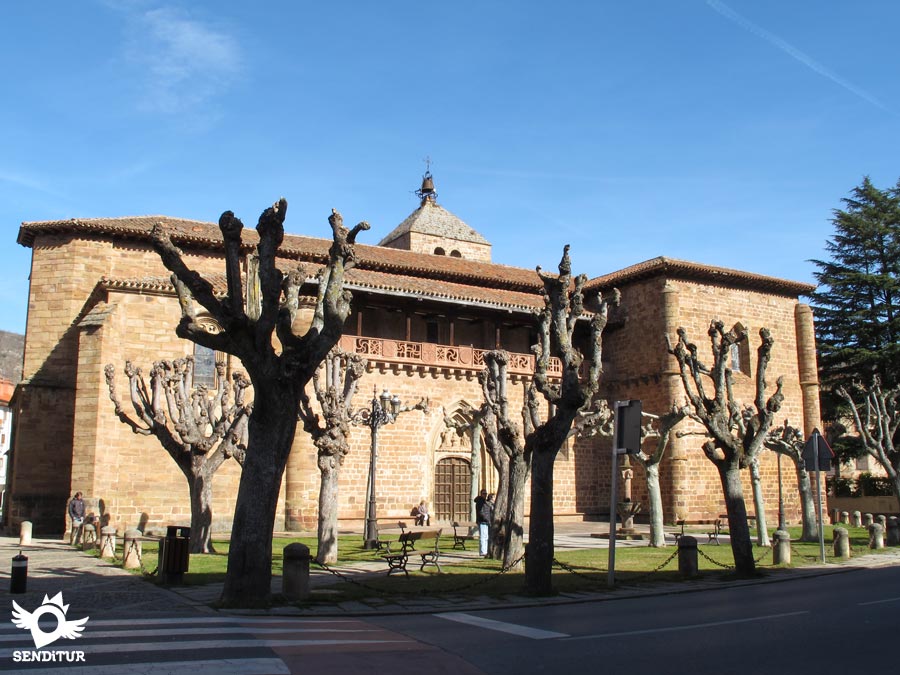It is located to the southwest of the community, in the upper part of the Oja valley, surrounded by high mountains. Although remains from the Palaeolithic and Neolithic periods as well as Roman settlements have been found in the vicinity of Ezcaray, its origin may be due to Basque settlers, as some authors situate the Autrigones as settlers of the highlands of the Oja valley. Their own name comes from the Euskera, Haitz-Garai, which means high rock, for the rock of about 200 m that rises to the entrance of the valley, La Picota de San Torcuato.

The first documented mention of Ezcaray dates from the 12th century. King Ferdinand IV granted it the Fuero del Valle de Ezcaray in 1312, by which its inhabitants were exempted from paying taxes or the porting of livestock and goods, but it also allowed to give refuge and asylum to the crooks who arrived in the valley, in order to repopulate it. Only Ezcaray had the power to judge them. The jurisdiction was confirmed by the Catholic Monarchs, but they annulled the malefactors. In this text already appears the denomination of Valdezcaray. In the XVII-XVIII centuries the textile industry had an important boom, with the creation of the Real Fábrica de Paños de Santa Bárbara, as well as livestock and mining, with a number of forges and thus giving rise to the existence of the old railway line, now converted into a greenway, with its station. After the War of Independence, in the nineteenth century, came a slight decline overcome today by far thanks to both its furniture industry and armchairs, as a proliferating tourism.
Ezcaray has a town centre with porticoed squares, arcades and well preserved palaces, as well as popular architecture and beautiful corners. The Real Fábrica de Paños (Royal Cloth Factory) from the 18th century, today the seat of the town hall, is also among its important civil monuments.

The hermitages of the Virgen de Allende and the Santa Barbara, as well as the palaces of Barroeta and Ángel, both from the 18th century, should also be highlighted. Above all, the church of Santa María la Mayor, built between the 12th and 16th centuries in a unique Aragonese Gothic style in La Rioja, looks like a fortress palace due to its cylindrical buttresses that reinforce its angles and also has a beautiful balcony. In Ezcaray you can also enjoy nature and the mountains along the GR 93 and the high Iberian valleys along the GR 190, strolling along the Oja Greenway, enjoying the peaks of the Sierra de La Demanda or skiing.

The 10th of August, festivities of San Lorenzo, patron saint of the town. They are celebrated throughout the week with different activities, one of the most classic being the pilgrimage that takes place on the day of the Saint to the mountain that bears his name where a mass is celebrated. The patron saint of Ezcaray is the Virgen de Allende and it is celebrated on 24 September. The most traditional festivities are those of Santa Bárbara, on Pentecost Monday in May, you go up to the hermitage which is located a short distance away and after the mass the women carry the image of the Saint in procession. On the 24th of June, San Juan, a pilgrimage is held to Cilbarrena, where the brotherhoods of the Saint draw lots for a lamb and distribute wine with soda.

A tradition of medieval origin is the distribution of Las Habas de San Benito, which recalls when the monks of the priory of Santa María de Ubaga, which was located near the now unpopulated village of Cilbarrena, distributed them between the poor of Ezcaray and the villages. Today, around 21 March, the confreres prepare large pots of beans to be offered to those who come to the village. Las Aleluyas, is another custom or tradition that is celebrated on Easter Sunday, in which the authorities after the mass, from the balcony of the church throw to the young people and children gathered in the square, candy and money.
Upper Oja is a natural region located in the northwestern area of the Iberian System, is part of an old Paleozoic massif called Sierra de La Demanda, whose name is given by a lawsuit filed by localities in the area for the use of their pastures.
MORE ROUTES AVAILABLE, DON'T MISS IT...
MORE PLACES AVAILABLE, DON'T MISS IT...
Ezcaray can be reached by following the LR-111 from Santo Domingo de la Calzada or by this same road but from the neighbouring town of Burgalesa de Pradoluengo. The road LR-111, allows us to connect to the height of Haro with the AP-68. In Santo Domingo de la Calzada you will also find the N-120 and the A-12 dual carriageway between Logroño and Burgos.
Ezcaray has a daily bus service, which connects it with Stº Domingo de la Calzada and Logroño.
SENDITUR is not responsible for any variation in the information described, as well as for the misuse of its guides and recommends that everyone be responsible and prudent in carrying out the activity. Likewise, we invite you to document yourself with books and specialized guides to complement the information described. From the commitment of SENDITUR with Nature and the respect to the balance of the environment, SENDITUR urges you to travel in a responsible way, with low environmental impact and respecting at all times the Natural, Cultural and Social environment wherever you go. For any suggestion, SENDITUR invites you to send an email to
Continue watching …